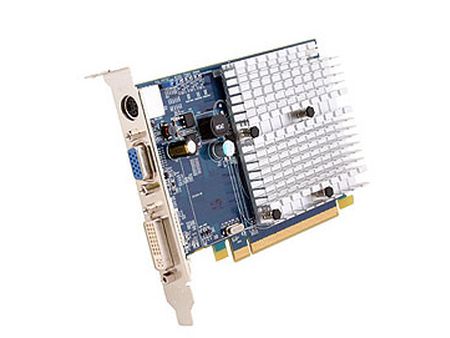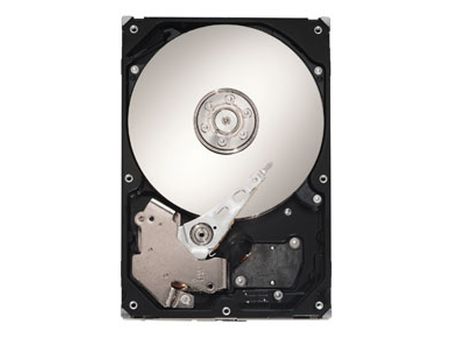Tom's Back To School Guide: Gear for Work
More Small Form Factor Parts
By: Chris Angelini
Graphics: Sapphire Radeon HD 3450 256MB DDR2
We’re already using the 780G’s integrated core, which offers two independent display outputs. However, AMD’s popular mainstream chipset also supports a feature called Hybrid Graphics, where an add-in card can work in tandem with the built-in core for enhanced 3D performance. Alternatively, you can also use the discrete card’s outputs to connect another couple of displays.
Ideally, you’d match the 780G’s Radeon HD 3200-series core up to a comparable solution for the best balance between price and performance. The Radeon HD 3450 is perhaps the most closely configured board in AMD’s discrete lineup, so it’s the card we chose to drop into Gigabyte’s motherboard. Armed with 40 stream processors, a 64-bit memory path, built-in video decoding hardware and HDMI output, it’s quite the package at under $40.
Sapphire’s take on the Radeon HD 3450 is particularly attractive: the PCI Express x16 board is passively cooled, doesn’t require auxiliary power, and features one DVI and one VGA output. You won’t see stunning performance numbers from the Hybrid Graphics solution, but after all, this is a work machine: it’s quiet, inexpensive and surprisingly feature-laden. While you could certainly drop the add-in card altogether and run off the integrated core, we think the extra investment is well worth it — especially when you consider the cost of a quad-output card like NVIDIA’s Quadro NVS 440 needed to enable similar functionality.
Storage: Seagate Barracuda 7200.11 ST3500630AS 500 GB HDD
Again, we’re using restraint here to keep the cost of this back-to-school workstation in line with a student’s budget. Nothing would bring us more joy than a RAID 5 array of Seagate’s new 1.5 TB SATA drives. However, 500 GB of capacity is still impressive, as is the $85 price tag on the company’s Barracuda 7200.11 model.
Based on second-generation perpendicular magnetic recording technology, Seagate’s Barracuda is a great little two-platter drive armed with 32 MB of cache and a standard 7,200 RPM spindle. It idles at a relatively quiet 25 dB and averages around 11 W of operating power consumption. Seagate guarantees the drive for five years and assigns it a 750,000 hour MTBF. Optimizations in areal density, performance, and power consumption make this a solid value proposition.
Rounding Out the Edges
Our itty-bitty workstation is just about finished. It needs some memory, an optical drive (which the In Win chassis accommodates) and perhaps a bit of wireless networking support.
For a low-cost, diminutive workstation, we weren’t as concerned about memory with overclocking headroom so much as we wanted a DDR2-1066 kit with aggressive timings; capacity was an issue as well. A 4 GB kit would beg to be paired to a 64-bit operating system, while a 2 GB solution might not be enough for your typical four-year bachelor’s degree — and definitely not sufficient for this writer’s six-year “extended stay” program. So, we erred on the side of longevity and selected OCZ’s DDR2 PC2-8500 Platinum 4GB dual-channel package, ducking in at under $100 after an available mail-in rebate.
As for optical storage, we were torn between the entertainment value of a Blu-ray player and utility of a DVD burner. In the end, we went with the more business-minded writer, and looked in Plextor’s direction for a suitable solution — after all, the company used to manufacture some of our favorites. But once we realized that the newest PX-820SA is a re-badged Optiarc AD-7200S, we went straight to the source, and in so doing, cut the price in half. The Sony/NEC Optiarc is a 20x DVD+/-R writer also able to handle RW media, dual-layer, and DVD-RAM discs. It’ll do everything you need from a burner, save Blu-ray, at just above $25.
Wireless networking is situational, of course. The Gigabyte MA78GM-S2H includes a Gigabit Ethernet controller, which would be our first choice for maximizing the performance of data transfers — especially if you’re backing up to a networked storage device. But the draft spec of 802.11n provides for theoretical performance as high as 300 Mb/s today and that’s darned quick. Dorm room computers aren’t always in easy range of a Gigabit port, so we picked Linksys’ WMP300N PCI Adapter for making longer-range connections.
Total cost for the box? Just under $650. Granted, you’ll want to add at least one display and I/O. But the platform itself is solid, powerful, and relatively inexpensive.
Current page: More Small Form Factor Parts
Prev Page The Itty-Bitty Workstation Next Page The Big Guns of BusinessGet Tom's Hardware's best news and in-depth reviews, straight to your inbox.
-
njalterio Haha.....as a university student who will be heading back to school for my final year this August I must say so much of this is unnecessary.Reply
First off, if you are living at home and/or still in high school absolutely none of this is necessary. Use the home PC.
Second, If you are going away to college, then get either a cheap laptop or desktop and one ethernet cable. End of story. You will be able to print through your university's printers, and most likely you will be able to get very cheap software from the university. I can buy Vista Ultimate for $15. Norton Antivirus is free.
Third, do not buy Apple as it is way to expensive. As a college student your money would be much better used elsewhere. This article did not do justice to Lenovo at all. I highly recommend a ThinkPad T61. (I priced a 2.4 GHz dual core and 4 GB of RAM and 100 GB hard drive for around $1100). The same hardware configuration would cost over $3000 in a Mac.
4) DO NOT SPEND MONEY IN WARRANTY/REPAIR/TROUBLESHOOTING SOFTWARE OR SERVICES! At your university there will be many smart and intelligent people who will be able to help you out for free. Depending on the size of your university, there will probably be a free tech support service somewhere on campus.
-
What about those of students who are in engineering and need laptops that can handle lots of CAD, a simple budget laptop will not do. Look at Mississippi State's requirements in the engineering dept for entering freshman, a required 256 bit gpu and they recommend 512 bit. Just wondering if we could see something more high end for the technical fields, this is a great read thoughReply
-
njalterio I am also a student in engineering and I am quite familiar with the computer hardware required. If you are an engineering major, then you should invest $200 more to get a laptop or desktop with discrete graphics.Reply
I was pointing out that a getting a $3000 laptop is ridiculous, and definitely should not be considered "vital" for back to school. -
mitch074 Overall quite nice, but:Reply
- getting a Thinkpad may be more expensive, but it has two enormous advantages: it's extremely sturdy, and it is easily serviceable; if you want to keep your laptop for 3 years, you'll have a better time with it than any other laptop series
- Google Docs is nice, but it requires an always-on Internet connection. I can't, for the life of me, understand why there's no OpenOffice.org mentioned anywhere: it's free, it's powerful, it's stable, and it's available for all systems cited (yes, even MacOS X - Aqua version will be out in september).
- if all you do is type notes and browse the Web, a netbook may just be what you need: lighter, smaller, cuter, faster to boot. It is also far less expensive. The MSI Wind and it's rather large screen and keyboard are a good thing, you can still get an USB keyboard and connect it to a flat screen TV to turn it into a more comfortable workstation in your dorm room.
For those of you telling me that 'Vista is required', bull: the Apple one runs OS X, you can run Linux or XP without trouble in such a context (yes, there is Java and Flash support under Linux; even Google Earth runs very well). -
gaiden I hope you chain that 24" LCD to an iron desk in your drom room. Best things for college are FREE or Second hand, no need to pay premium $$$ for new stuffs. I pay for my own tuition and all my other expense, so there is no way a 'regular' student or their parent will consider buying something this big and pricy. PC component side are decent however.Reply
The dude above who asks for a Laptop/notebook to work on CAD, maybe a Dell Vostro 1500 and possibly runs in XP. CAD doesn't have all the support from Vista yet...i don't think. Basically if you are all work and no play just make sure you get a Core 2 Duo CPU with a Quadro card and 3-4gb of RAM. If you play some games get a C2D/3-4gb RAM and a Nvidia 8600 and up instead of a Quadro
gl -
cangelini gaidenI hope you chain that 24" LCD to an iron desk in your drom room. Best things for college are FREE or Second hand, no need to pay premium $$$ for new stuffs. I pay for my own tuition and all my other expense, so there is no way a 'regular' student or their parent will consider buying something this big and pricy. PC component side are decent however. The dude above who asks for a Laptop/notebook to work on CAD, maybe a Dell Vostro 1500 and possibly runs in XP. CAD doesn't have all the support from Vista yet...i don't think. Basically if you are all work and no play just make sure you get a Core 2 Duo CPU with a Quadro card and 3-4gb of RAM. If you play some games get a C2D/3-4gb RAM and a Nvidia 8600 and up instead of a QuadroglReply
Ain't it the truth. Nothing tweaked me more than when I had an old-school HP notebook nabbed from my office on-campus during a two minute bathroom break. A shame you have to lock everything down just to let it out of your sight for a second.
-
In my opinion, if you don't play or make games, do scripting or anything else that may take lots of processing power you dont need to spend more than like... 300$ on a computer. To cut down on the price I would get 1gb 667 mhz (15$) of RAM, a Pentium Dual-Core (about 60$) and a PCI video card for about 50$. It would no doubt be more than enough for surfing the internet, watching movies, and using MS Word.Reply
-
mbmcavoy For students in a technical field, (engineering, computer science, etc), a Windows laptop probably is best due to specialty software/hardware needs. But for the majority of students in non-technical fields, I'd highly recommend the MacBook.Reply
Sure it seems more expensive if you compare hardware spec sheets, but the OS and included Apps make it a worthwhile package. Plus, iWork is much cheaper than MS Office. (Oh, and currently a free $300 iPod Touch for students and teachers sweetens the pot!)
General setup and maintenance issues are much less, so you'll have more time for actual studying - especially important for the non-techie! And while Windows has "sleep" features, I've never had consistent success with it. The sleep on my MacBook is bulletproof, and it wakes up in about 1 second. Perfect for the mad dash between classes!
Of course, if you are a non-techie, you probably aren't reading THG... :)



